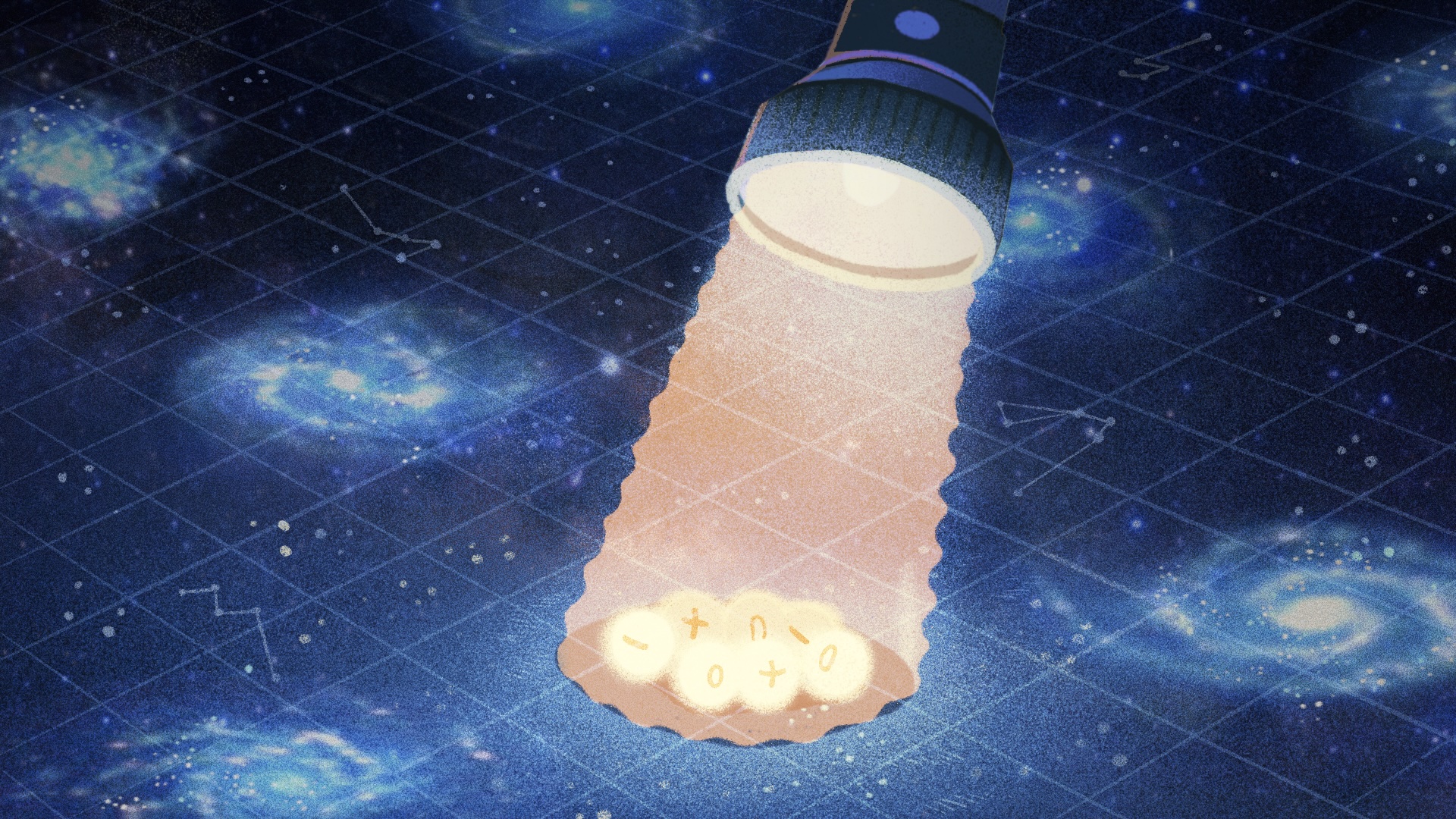‘Like trying to see fog in the dark’: How strange pulses of energy are helping scientists build the ultimate map of the universe
By Perri Thaler
Copyright livescience

Skip to main content
Close main menu
Live Science
Sign up to our newsletter
View Profile
Search Live Science
Planet Earth
Archaeology
Physics & Math
Human Behavior
Science news
Life’s Little Mysteries
Science quizzes
Newsletters
Story archive
Lab brains could become conscious
Jaguar smashes swim record
Mysterious hand positions on Maya alter
It’s too late to stop AI, readers say
Anthropologist Ella Al-Shamahi on human origins
Don’t miss these
James Webb telescope pinpoints brightest FRB ever detected
Farthest ‘mini-halo’ ever detected could improve our understanding of the early universe
Black Holes
Giant, cosmic ‘Eye of Sauron’ snapped staring directly at us in stunning 15-year time-lapse photo
Scientists may have found a powerful new space object: ‘It doesn’t fit comfortably into any known category’
‘Time machine’ reveals hidden structures in the universe’s first galaxies
Scientists capture bridge of stray stars being sucked from one galaxy to another
Black Holes
Astronomers use rare ‘double zoom’ to view black hole corona in unprecedented detail
Black Holes
See the universe’s rarest type of black hole slurp up a star in stunning animation
Black Holes
Scientists use Stephen Hawking theory to propose ‘black hole morsels’ — strange, compact objects that could reveal new physics
Scientists find ‘something extraordinary’ in famous supernova’s troubled heart
‘Ice cube’ clouds discovered at the galaxy’s center shouldn’t exist — and they hint at a recent black hole explosion
Echoes from the Big Bang suggest Earth is trapped inside a giant cosmic void, scientists claim
Scientists may finally know why the first stars in the universe left no trace
100 undiscovered galaxies may be orbiting the Milky Way, supercomputer simulations hint
Black Holes
Colossal black hole 36 billion times the mass of our sun is one of the largest ever seen in the universe
‘Like trying to see fog in the dark’: How strange pulses of energy are helping scientists build the ultimate map of the universe
Perri Thaler
19 September 2025
Astronomers are using radio pulses from space to find missing baryonic matter and learn about supermassive black holes, stellar formation and galaxy evolution.
When you purchase through links on our site, we may earn an affiliate commission. Here’s how it works.
Fast radio bursts are helping scientists find missing matter across the universe and understand large-scale cosmic structures.
(Image credit: Wei-An Jin)
In early 2024, McGill University doctoral student Vishwangi Shah and her colleagues were conducting a routine review of data from the Canadian Hydrogen Intensity Mapping Experiment when they noticed something strange.
Their analysis traced one of these pulses, known as fast radio bursts (FRBs), to the outer edge of a “dead” galaxy with no new stars. By all logic, that region of space should have been silent. Instead, it was shouting across the universe, sending out hugely energetic waves.
The team was baffled. If their calculations were right, the finding suggested that FRBs may be produced through processes we didn’t expect, and far more often than predicted.
You may like
James Webb telescope pinpoints brightest FRB ever detected
Farthest ‘mini-halo’ ever detected could improve our understanding of the early universe
Giant, cosmic ‘Eye of Sauron’ snapped staring directly at us in stunning 15-year time-lapse photo
Science Spotlight takes a deeper look at emerging science and gives you, our readers, the perspective you need on these advances. Our stories highlight trends in different fields, how new research is changing old ideas, and how the picture of the world we live in is being transformed thanks to science.
They immediately combed through their code, searching for any errors that might explain away the anomaly. When their search came back clean, they realized the implication — they might have stumbled upon a way to solve an unrelated, decades-old cosmic mystery: why a big portion of the universe’s “ordinary” matter is missing.
This “normal” matter, called baryonic matter, includes particles like protons and neutrons and other matter that interacts with light, including stars, planets and us. Baryonic matter makes up a small percentage of the universe; the rest comprises mysterious dark energy and dark matter, which are invisible to human eyes.
There should be more ordinary matter in the universe than what we have detected. And the FRB that Shah and her colleagues had detected was a bright, shining beacon pointing to some of that missing matter. As FRBs traverse vast cosmic distances, they can be perceptibly slowed by the presence of baryonic matter — but not by its dark counterpart. Studying these incredibly brief flashes of light, therefore, could be a serendipitous tool for finding the universe’s missing matter.
Related: Object mistaken as a galaxy is actually a black hole pointed directly at Earth
Sign up for the Live Science daily newsletter now
Get the world’s most fascinating discoveries delivered straight to your inbox.
Contact me with news and offers from other Future brandsReceive email from us on behalf of our trusted partners or sponsorsBy submitting your information you agree to the Terms & Conditions and Privacy Policy and are aged 16 or over.
Now, scientists are doing just that: They’re trying to use FRBs to create a map of the universe’s matter. What they are learning could reshape what we know about how stars, black holes and galaxies grow over time.
The “missing baryon problem”
Baryons are the class of subatomic particles that includes protons and neutrons, the basic building blocks of atoms, as well as a handful of ultra-rare, exotic particles that are thought to make up a tiny percentage of baryons. Baryons are found in all of the visible matter in the universe but not in the mysterious dark matter that exerts gravitational pull but does not interact with light.
In the 1990s, scientists analyzed the elements created by the Big Bang and calculated that baryonic matter should make up about 5% of the total mass and energy in the universe. This model of the Big Bang, called the Lambda Cold Dark Matter (Lambda-CDM) model, is generally accepted by experts as most likely to represent what happened.
You may like
James Webb telescope pinpoints brightest FRB ever detected
Farthest ‘mini-halo’ ever detected could improve our understanding of the early universe
Giant, cosmic ‘Eye of Sauron’ snapped staring directly at us in stunning 15-year time-lapse photo
But where is all that matter? Across all planets and stars, scientists can find only around 70% of the baryons they predicted should be in the universe. “It’s basically a cosmic bookkeeping problem,” Manisha Caleb, an astrophysicist at the University of Sydney, told Live Science in an email. The discrepancy between the amount of baryonic matter astronomers predicted and the amount they could prove exists became known as the “missing baryon problem.”
The missing matter was elusive, and more researchers joined the hunt to find it. “It’s kind of annoying and embarrassing to be missing much of the normal ordinary matter in the universe,” Liam Connor, an astrophysicist at Harvard University who studies this matter, told Live Science.
“It’s kind of annoying and embarrassing to be missing much of the normal ordinary matter in the universe.”Liam Connor, Harvard University
Astronomers pointed their telescopes at different types of cosmic objects but couldn’t find the missing baryons. Many expected the missing matter to be in wisps of hot plasma that are spread thinly between galaxies, Caleb said. Observing this “warm-hot intergalactic medium” is difficult because it is diffuse and emits very little light, rendering it nearly invisible to current observational instruments. “It’s like trying to see fog in the dark,” Caleb said.
Finding the missing baryons would help support — or rule out — certain models of the Big Bang. That’s because the composition of the early universe, specifically the number of baryons, is tied to the abundance of different elements. Models like Lambda-CDM predict the existence of specific amounts of hydrogen, helium and other light elements at the start of the universe, which can still be measured today. Finding a number of baryons that better matches the predicted elemental abundance is a sign their models are more likely to be accurate.
If that matter doesn’t exist, however, “it would mean something is wrong with our models,” Julian Muñoz, a theoretical cosmologist at The University of Texas at Austin, told Live Science in an email. Therefore, there might be gaps in scientists’ understanding of cosmic history.
Duncan Lorimer identified the first FRB in 2007 while searching through archival telescope radiation data from 2001. He and his team encountered this anomaly in frequency, which lasted less than 5 milliseconds and indicated the observation of a strange burst of radio waves, later called an FRB. (Image credit: Psr1909, CC BY-SA 4.0, via Wikimedia Commons)
A new strategy: fast radio bursts
Scientists have been measuring FRBs using radio telescopes since 2007, when Duncan Lorimer, an astronomer at West Virginia University, made the first discovery of an FRB by accident. Every burst is hugely energetic, releasing more energy in a fraction of a second than the sun does over several days.
True to their name, fast radio bursts are quick; most last around a millisecond. Because they are so short-lived and can originate in any part of the sky, FRBs are often detected by chance. This fleeting nature also makes it difficult to pinpoint where FRBs come from, as astronomers usually have, at most, only a few milliseconds to take measurements.
For that reason, FRB research originally focused on finding the origins of the pulses. Most theories suggest that they come from young magnetars, which are highly magnetized neutron stars — the ultradense collapsed cores of massive stars.
Then, Shah’s observation, along with an earlier one from 2020, challenged this model. The discovery of errant FRBs galvanized astronomers because it meant there was a new way to hunt for missing matter. How FRBs form is “a big and very interesting puzzle,” Lorimer told Live Science.
If Shah’s FRB (named 20240209A) comes from a dead galaxy, then perhaps older magnetars could also beam FRBs into the cosmos — meaning some FRBs may be the last gasps of dying stars. An old magnetar, much like a cooling campfire, may seem quiet and unenergetic, but hidden stresses can still ignite a quick spark.
It’s also possible that, under the right conditions — perhaps as old stars merge or as matter builds up around a dead star — new magnetars can form in dead galaxies. There would then be many more FRB sources than scientists previously expected.
Even in 2007, Lorimer thought his work might have broader applications. His paper identifying the first FRB alludes to the possibility of using FRBs to probe the warm-hot intergalactic medium, which was tricky to study with the tools available then.
But scientists didn’t explicitly propose using FRBs to find baryonic matter until 2013. In a paper published in The Astrophysical Journal Letters, Matthew McQuinn of the University of Washington proposed pinpointing the missing matter by measuring how much an FRB has slowed as it goes past and through matter on its trajectory — called the dispersion measure.
FRBs are uniquely suited to finding baryonic matter. Because of their high energy levels, FRBs also travel long distances, sometimes through the warm-hot intergalactic medium, and are not affected by dark matter because dark matter doesn’t interact electromagnetically. “As far as dark matter is concerned, the FRB doesn’t exist, and vice versa,” Connor told Live Science.
Most theories suggest that FRBs come from young magnetars — highly magnetized, ultradense collapsed cores of massive stars. (Image credit: ESA)
Much of the observable universe’s matter, including the warm-hot intergalactic medium, lies in extremely thin, spread-out gas that is nearly invisible to conventional telescopes. FRBs act as beams of electromagnetic energy, like strong flashlights, that pass through these groups of matter, interacting with particles that change the frequency of FRB waves. Sensors on Earth can measure the frequency of those FRB waves once they reach us and, using complicated analysis, scientists can calculate the dispersion measures.
Scientists didn’t put this method to the test until 2020, when a team including McQuinn and his international colleagues applied it to real FRB observations. Using 13 robust FRB dispersion measurements, the team created a model of the cosmic structure of the universe. They calculated that baryons account for roughly 5% of total matter and energy, just as past methods predicted, providing a proof of principle that FRBs can be used to unmask missing matter.
This result also revealed that the current number of baryons in the universe has not changed since the Big Bang and reinforced the prevailing Lambda-CDM model.
In June 2025, Connor and his collaborators used FRBs to estimate where all baryons were located. Their calculations suggested that about 76% of all baryons are in the space between galaxies. “We can actually pinpoint where they’ve been hiding all along,” Connor said. “They’re in this wispy, diffuse, ionized state in between the galaxies and in a sort of baryon cosmic web, you might call it.”
Therefore, the other 24% of baryons must be elsewhere in the universe, they predicted.
“A baryonic Google Maps”
Understanding the distribution of baryonic matter is critical because it has implications for supermassive black holes, stellar evolution and galaxy formation. “If we can pin down where the missing matter is, we can build much better models of everything from how galaxies recycle gas to how elements get spread through the universe,” Caleb said.
The distribution of baryonic matter around supermassive black holes could shed light on how the cosmic behemoths at the hearts of distant galaxies self-regulate. Scientists have figured out that “if things get too hot, [the supermassive black hole] cools itself down. If things chill out, it gets hot and starts forming stars or burping gas into the intergalactic medium,” Connor explained.
An understanding of this process, widely accepted by experts since the mid-2000s, helps scientists predict how galaxies evolve. But for distant galaxies, it’s hard to measure a black hole’s heating and cooling. With enough information about the distribution of baryons around a distant galaxy, astronomers can thus make predictions about how the specific galaxy developed and formed stars.
As soon as an FRB is detected, CHIME telescopes across three continents can tune in and help pinpoint it. (Image credit: CHIME Collaboration)
The amount and pattern of the surrounding baryons also inform scientists about how stars form. And because galaxies are made of stars and black holes, understanding how their growth and formation alter baryonic distribution can teach astronomers about how galaxies grow over time, Muñoz said.
The field is limited by the small number of FRBs that have been pinpointed. To determine a burst’s origin, scientists use dispersion measures to reveal how far an FRB traveled to get to Earth. Working backward and taking into account the expansion rate of the universe, astronomers can use the distance traveled to find where an FRB came from.
Although astronomers have observed several thousand FRBs, only about 50 have been traced to their origin.
“The next steps are about scale,” Caleb said. “We need hundreds — ideally thousands — of well-localised FRBs so we can use them like pins in a cosmic map.”
With more of these locations determined, astronomers will be able to statistically analyze the spatial distribution of matter in the universe. These FRBs could tell us where ordinary matter lies, and celestial objects that interact with dark matter, like galaxies, can point to the locations of dark matter. Together, these pieces of information can reveal the underlying, invisible structure of the universe that connects galaxies and determines how they’re arranged.
“In 10 to 20 years, I’d love to see a full 3D map of the baryon distribution across the universe, traced out by FRBs — like a baryonic Google Maps” to use in conjunction with knowledge of dark matter, Caleb said. And there’s hope for this dream.
RELATED STORIES
—Mysterious deep-space radio signals reveal location of the universe’s ‘missing matter’
—Where do fast radio bursts come from? Astronomers tie mysterious eruptions to massive galaxies.
—Mysterious, repeating radio bursts from space may finally have an explanation
Projects like the Canadian Hydrogen Intensity Mapping Experiment (CHIME) and the Deep Synoptic Array 2000 (DSA‑2000) in Nevada are in the midst of building out their FRB detection capabilities. CHIME is developing three telescopes that work together across continents, so as soon as an FRB is detected, all of the telescopes can tune in and help pinpoint it. The DSA‑2000, meanwhile, will survey the entire sky several times with nearly 20 times more antennae than its predecessor, the Deep Synoptic Array-110, to increase measurement sensitivity by decreasing noise in radio observations.
These instruments, when fully operational, are expected to collectively find the origins of more than 10,000 FRBs per year.
“This is just the beginning” of leveraging FRBs to learn more about the universe, Caleb said.
Black hole quiz: How supermassive is your knowledge of the universe?
science spotlight
Perri Thaler
Social Links Navigation
Perri Thaler is an intern at Live Science. Her beats include space, tech and the physical sciences, but she also enjoys digging into other topics, like renewable energy and climate change. Perri studied astronomy and economics at Cornell University before working in policy and tech at NASA, and then researching paleomagnetism at Harvard University. She’s now working toward a master’s degree in journalism at New York University and her work has appeared on ScienceLine, Space.com and Eos.
You must confirm your public display name before commenting
Please logout and then login again, you will then be prompted to enter your display name.
James Webb telescope pinpoints brightest FRB ever detected
Farthest ‘mini-halo’ ever detected could improve our understanding of the early universe
Giant, cosmic ‘Eye of Sauron’ snapped staring directly at us in stunning 15-year time-lapse photo
Scientists may have found a powerful new space object: ‘It doesn’t fit comfortably into any known category’
‘Time machine’ reveals hidden structures in the universe’s first galaxies
Scientists capture bridge of stray stars being sucked from one galaxy to another
Latest in Astronomy
Skywatching alert! See 2 bright comets on the same night as a meteor shower this October
Saturn will be at its biggest and brightest on Sept. 21 — here’s how to see it
‘Dramatic’ changes spotted in first black hole ever imaged
See the moon, Venus and Regulus in a rare triple conjunction tomorrow
‘The sun is slowly waking up’: NASA warns that there may be more extreme space weather for decades to come
There’s a 90% chance we’ll see a black hole explode within a decade, physicists say
Latest in Features
What are the ‘magic numbers’ in nuclear physics?
‘Like trying to see fog in the dark’: How strange pulses of energy are helping scientists build the ultimate map of the universe
A tragic gene therapy death that stalled the field for a decade — Sept. 17, 1999
Why does your breath sometimes stink even after brushing your teeth?
Volcanic ‘googly eyes’ stare into space from skull-like peninsula
James Webb telescope’s ‘starlit mountaintop’ could be the observatory’s best image yet — Space photo of the week
LATEST ARTICLES
Why does your breath sometimes stink even after brushing your teeth?
‘Like trying to see fog in the dark’: How strange pulses of energy are helping scientists build the ultimate map of the universe
If tiny lab-grown ‘brains’ became conscious, would it still be OK to experiment on them?
Cold snap in Florida made Burmese python puke up a whole deer
Vast source of rare Earth metal niobium was dragged to the surface when a supercontinent tore apart
Live Science is part of Future US Inc, an international media group and leading digital publisher. Visit our corporate site.
Contact Future’s experts
Terms and conditions
Privacy policy
Cookies policy
Accessibility Statement
Advertise with us
Web notifications
Editorial standards
How to pitch a story to us
Future US, Inc. Full 7th Floor, 130 West 42nd Street,
Please login or signup to comment
Please wait…



